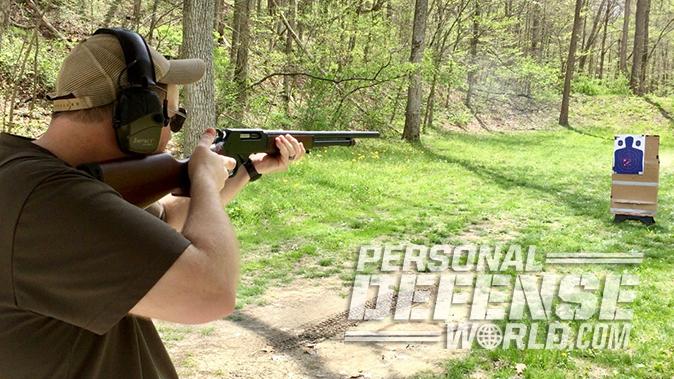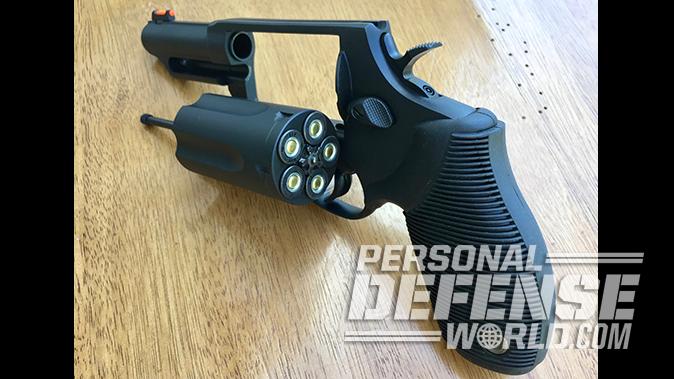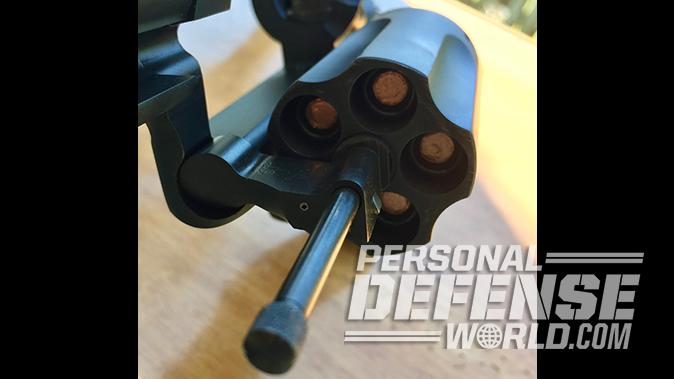In the days of the Old West, lawmen, outlaws and cowboys had to limit how much they carried on the backs of their horses. It wasn’t too long after Winchester came out with the Model 1873 rifle in .44 WCF (.44-40) that Colt decided to introduce its Model 1873 Single Action Army in the same caliber and call it the Frontier Model. This wise move allowed a horseman to carry only one cartridge to use in both the long gun and handgun. Down through the years, this tradition has been maintained with other handgun-caliber cartridges like the .357 Magnum, .44 Magnum and .45 Colt. Now Henry Repeating Arms and Taurus make it possible to have a long gun and handgun combination that chambers .410 shotshells.
Going Long
Introduced this year, the Henry Lever Action .410 Shotgun is based on the company’s large-sized .45-70 Government models, as a 2.5-inch .410 shotshell is similar in size to the long, straight-walled .45-70 cartridge. This provides the strength and ruggedness, along with the weight, of a big-bore rifle and gives a platform for the milder-shooting .410 that will last the lifetime of the owner and beyond. At present, the .410 Lever Action Shotgun comes in two versions. One has a 20-inch, round, cylinder-bore barrel (Model H018-410R) that is set up with a brass bead front sight and a fully adjustable, semi-buckhorn rear sight. The other (Model H018-410) has a 24-inch, round, smoothbore barrel that has a factory-installed Invector-type full choke at the muzzle, which is removable and can be replaced with additional chokes (sold separately). It has a simple large brass bead near the muzzle and no rear sight.
Advertisement — Continue Reading Below
Commonalities between the two guns include blued steel receivers, barrels, magazine tubes, forend caps, levers, hammers and triggers. The pistol grips, buttstocks and forends are made of dark, straight-grained, checkered American walnut with sling swivel studs. At the rear of the buttstock is a black rubber recoil pad that provides a non-slip surface for the shoulder.
I requested a test gun from Henry, and the company sent me its Model H018-410 with the 24-inch barrel and bead front sight. An examination of the exterior showed exacting workmanship with an above-average fit and finish. The bluing had a matte/satin finish, and the checkering on the American walnut stock and grip, straight-grained but attractive, was very precise. My only criticism would be the little circular indents on the right side of the trigger, which looks like an investment casting.
Like all Henry lever actions, the .410 shotgun has a tubular magazine that is loaded from a slot near the front of the tube. The inner brass tube is held in place by a stud that locks into a slot in the magazine retention ring below the barrel. The two-thirds-type magazine holds five shells, giving you a 5+1 capacity. There is no safety or half-cock on the hammer.
Advertisement — Continue Reading Below
All together, this substantial shotgun is 44.5 inches long and weighs 7.5 pounds.
Handheld Judge
The Taurus Judge revolver has been out now for over a decade and has garnered a pretty good following. To pair up with the Henry, I wanted one of the longer-barrel versions, but all that was available was a model with a 3-inch barrel.
This wheelgun is built on a medium frame with a five-shot cylinder, which, unlike the Henry, will accept 3-inch .410 shotshells, plus it chambers .45 Colt cartridges. It’s a traditional double-action/single-action (DA/SA) design with a swing-out cylinder that locks at the rear and at the crane/frame juncture. Both the trigger and hammer are target-width; the trigger face is smooth and the hammer spur is checkered. The DA pull is even and not overly heavy while the SA pull is crisp. It has a transfer bar internal safety feature, plus the action-locking Taurus Security System. The barrel has shallow rifling for when .45 Colt ammo is used, but it doesn’t negatively affect the .410 rounds.
Advertisement — Continue Reading Below
The gun is fitted with a red fiber-optic front sight and has an integral rib on top and an ejector rod shroud. The rear sight is a fixed notch and channel in the topstrap. Taurus’ excellent Ribber rubber grips come on the Judge; they really give you something to hang onto and control recoil and muzzle flip well. Overall, the fitting between the metal components and the grip on my test blued model were top class.
There’s really no question that the Taurus Judge is meant to be a defensive weapon. I can also see some usefulness in the field or on the trail, especially for close-range pests or poisonous reptiles. The 24-inch-barreled Henry Lever Action .410 Shotgun bespeaks hunting or field use. The longer barrel, full choke and brass bead sight make this a good choice for small game like squirrels or rabbits or even wing-shooting for quails or doves. There’s also a possibility of some close-range use on varmint-sized critters with slug shells.
The 2.5-inch Foster-type slug weighs in the vicinity of 88 grains (0.2 ounces) and is propelled to about 1,830 fps, giving it some 654 foot pounds of muzzle energy— nothing to take lightly. So you see is that this handgun/long-gun combination has quite a bit of versatility. However, I don’t believe it would be anyone’s first choice for self-defense. The idea is to look at this combination as a “use what you’ve got” proposition and see how things pan out in the event these guns had to be used for defending hearth and home.
Advertisement — Continue Reading Below
Feeding Time
For the Taurus Judge, I selected a .45 Colt load from HPR that propels 250-grain JHPs at 837 fps. As you probably already know, this .45 Colt ammunition won’t work in the Henry shotgun, so don’t even try it. Given the popularity of the Judge and its variations, ammunition makers have stepped up and provided a number of 2.5-inch shells for the .410 bore specifically for defensive applications. I chose two loads from Federal Premium, both of which are listed as part of the company’s Personal Defense line. One has 0.4 ounces of #4 shot at a listed velocity of 950 fps, and the other has four copper-plated 000 buckshot pellets with a velocity of 850 fps.
I also found some Herter’s Defense shotshells at a sporting goods outlet. This .410 load carries three 000 buckshot pellets at 800 fps. From Remington, I selected the Express Rifled slug and then Winchester’s 2.5-inch PDX1 shells, which contain three copper-plated “defense disks” on top of 12 plated BBs, all factory-rated at 750 fps. My guess is that these .410 handgun loads out of a 24-inch shotgun barrel could possibly up the velocity some 900 to 1000 fps. But, sorry, I wasn’t going to endanger my chronograph to find out. For game and pest use, I threw in 2.5-inch Remington Express high-brass #6 shotshells.
Punching Paper
At the range, my first task was to see what kind of accuracy was possible with the Taurus Judge using the .45 Colt HPR cartridges. This revolver is for close-range propositions, so I limited the distance to 7 yards and used reduced-size BC-27 silhouette targets. My best five-shot group from a rest position, shooting in SA, mode was 1.99 inches with an average of 2.11 inches for three 5-shot groups. The point of impact was very close to the point of aim.
Advertisement — Continue Reading Below
I switched to .410 slugs, and the first shot I pulled low into the 8 ring. The other four shots went into the X and 10 rings, making a 1.79-inch cluster. The recoil wasn’t bad at all, but with the velocity reduction out of a 3-inch barrel, I don’t think it would be my choice for defense. I then fired a PDX1 shot at the head and another center-mass. In both cases, the “defense disks” went high but clustered together rather well; the BBs scattered out with only seven pellets from each shell staying on the target paper.
I then fired five shots of this load all center-mass, and 12 of the 15 disks stayed inside the 9 and 10 rings and three went into the 8 ring; the BBs were dispersed all over the paper. One shot with the Federal #4 load convinced me that it wasn’t the way to go. The Federal 000 buckshot was another story, with two hits in the X ring and two in the 9 ring. The Herter’s 000 buckshot load put two in the 9 ring and one in the 7 ring. It had substantially less recoil than the Federal ammo.
First up in the Henry Lever Action .410 Shotgun were the Remington slugs. Using a rest at a distance of 25 yards, I put the bead sight on the X ring of the BC-27 target and fired five shots. I had a low hit that would have made the five-shot group 4.37 inches, but four shots were fairly close together at 2.75 inches. The point of impact was about 2 o’clock in the 7/8 ring, about 5.4 inches above and 3.1 inches right of the point of aim. At a distance of 10 yards, I shot one round of 000 buckshot from Federal and Herter’s; the Federal was well-centered, but the Herter’s gave me a center hit and two arm strikes.
Advertisement — Continue Reading Below
I then loaded up with three Federal and three Herter’s 000 shells. The full-choked barrel kept this pattern pretty tight in the center-mass with two pellets straying but still within the scoring rings. The long, full-choked barrel made the difference with the Winchester PDX1 shells. All the disks were slightly off-center in the 9 ring, and none of the BBs strayed outside the 8 ring. Shooting five PDX1 shoots quickly produced devastating results, with a ragged hole in the 9 and 10 rings and only two BBs outside the 7 ring in the right arm. I also shot at two gopher targets set up at 10 yards using the Federal #4 and Remington #6 loads, and neither gopher would have survived.
I found out a few things during these shooting tests. Both guns worked well, but make sure you seat the shells properly in the Taurus Judge, as the cylinder will bind; I had this happen with the Herter’s .410 shells, which seemed to have thicker, sloppier rims. These same shells also gave me one failure to extract in the Henry. The Henry likes to be handled with authority when working the lever; what it doesn’t like is the lever being worked with the gun at a sideways angle. Remember, the shells have a blunt front end.
I’m really impressed with close-range applications using the Judge/PDX1 combo. Considering the weight of the Henry, I don’t know if I’d carry it on a rabbit hunt in hill country, but at the range I had a lot of fun with it, and the more I shot it, the more impressed I became.
Advertisement — Continue Reading Below
Defensive Scenario
A close relative of mine was the fatal victim of a home invasion a while back, so I’m very cognizant that things can go south very quickly in this kind of incident. For that reason, my home-invasion repulsion plan (HIRP) includes a quickly deployable handgun at the front door with secondary handguns and a shotgun in my safe area, which can only be accessed through a stairwell. I was curious to see how the Henry .410 Lever Action and the Taurus Judge would work out when pressed into service in these capacities. The Taurus would be stand guard at the front door, and the Henry would guard the access area to the safe room.
My scenario involved two armed “perps” who force the door and are engaged at close range with the Taurus Judge. Two more subjects then gain entry, and an orderly retreat is made towards the safe room, where these two additional perps are engaged as they enter the confines of the stairwell. These subjects are fired on with the Henry Lever Action Shotgun.
Advertisement — Continue Reading Below
In both cases, both guns would be loaded with a mix of the most effective ammunition based on the previous findings from the handgun/long gun test and evaluation. Yours truly, being the erstwhile home defender, will respond to loud crashing at the front door, where the secreted Taurus Judge will be retrieved and a verbal challenge made to the intruders. The door having been breached, two B-27 silhouettes will be fired on from near-contact distance, with the weapon emptied. Moving rapidly to the top of the stairwell, the Henry shotgun will be retrieved and used on two more B-27 silhouettes at a distance of 10 feet. The actual “upstairs” shooting will be done from a raised platform at the range.
My son, Jordan, and I went through this scenario four times—the first time fairly slowly, the second time a bit faster. I used four evil-looking, full-sized bad guy targets, two of which were placed in a mock doorway, one slightly ahead of the other.
The Taurus Judge, loaded with Winchester PDX1, shells was placed on a table near the door. On signal, I moved to the door and engaged the targets, the first shot on the closest bad guy and then the second. The first target then was shot again and the second twice. I did this point shooting, strong-hand only. I then retreated towards the safe room with the empty Judge. This is when two more bad guys would come in through the door and start up the stairwell. They were engaged at about 10 feet with the Henry loaded with Remington slugs and Federal 000 shells.
Again, the targets had been placed one slightly to the rear, and the second was also shielded somewhat by the first target. I levered and fired one slug at the closest then farthest bad guys, and then the first bad guy got a dose of 000 buckshot, as did the second one.
An after-action report showed that the PDX1 .410 defense disks stayed close together and hit the first bad guy by the door in the upper chest (wads too)—one each in the hanging strings of his hoodie. The BBs were also dispersed inside the upper chest. The distance was about 4 feet. The second bad guy at the door got three shots; he was about a foot or so behind his partner. The disks hit close together in the chest, as did the wadding. The BBs patterned in the upper chest with three hits in the neck/head.
With the Henry, I took a quick aim with the front bead and the first stairs bad guy got a solar-plexus hit, then his partner. The first stairs bad guy had one 000 hit just to the right of the slug hole; the other 000 hit about 3 inches below the slug hole. The wads hit the gun hand and added to #2 buckshot hole. The second bad guy also had a shot just to the left of the slug hole; the wads hit his upper gun arm.
Final Verdict
Both the Taurus Judge and the Henry Lever Action .410 Shotgun performed well with no malfunctions during the drills. Both were fast handling. The recoil and muzzle blast weren’t an issue with either gun and were negligible at best. The guns were loaded with what I believed to be the best combination of ammunition for their particular role.
Given the distances and the multiple shots involved, I don’t think the bad guys would have been successful in their home invasion. The biggest criticism of the .410 defense loads is generally lack of penetration. Videos and photos I’ve seen of ballistic gelatin tests show penetration at around 5 to 8 inches depending on the load with a handgun. The slug and 000 buckshot in the 24-inch, full-choked barrel would be much better I’m sure. Neither would be my first choice for defense, but they work!
Henry Lever Action Shotgun Specs
| Gauge: .410 |
| Barrel: 24 inches |
| OA Length: 44.5 inches |
| Weight: 7.54 pounds (empty) |
| Stock: American walnut |
| Sights: Brass bead front |
| Action: Lever |
| Finish: Blued |
| Capacity: 5+1 |
| MSRP: $902 |
Taurus Judge Specs
| Caliber: .410/.45 Colt |
| Barrel: 3 inches |
| OA Length: 9.5 inches |
| Weight: 29 ounces (empty) |
| Grip: Rubber |
| Sights: Red fiber-optic front, notch rear |
| Action: DA/SA |
| Finish: Black |
| Capacity: 5 |
| MSRP: $589 |
For more information about the Henry Lever Action, visit henryusa.com. To learn more about the Taurus Judge, go to taurususa.com.





































